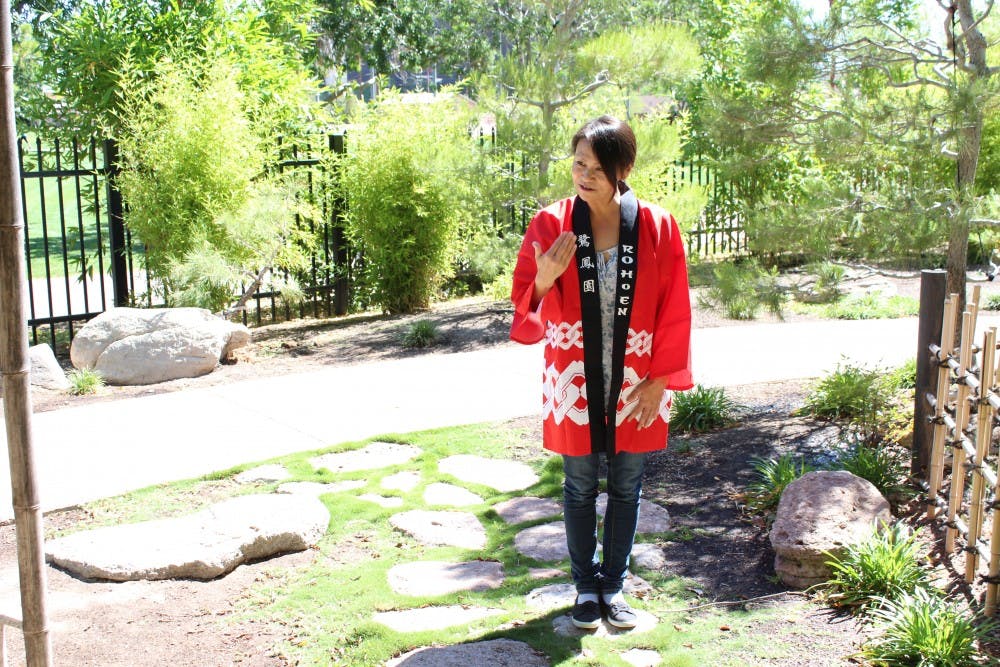For the Japanese, tea is a way of life. In addition to consuming it as an everyday beverage, the Japanese have long celebrated tea drinking with an elaborate ritual known as chanoyu, or a tea ceremony.
The ritual of a tea ceremony dates back to more than 1,000 years, when the Japanese Buddhist would consume tea as an energy source while meditating. However, the Japanese Friendship Garden of Phoenix preserves the experience, and offers a chance for guests to participate.
The garden is in close proximity to the ASU Downtown Campus. Giving students an opportunity to visit and explore the garden at lunch time or after classes. Being close to the garden means ASU students can visit the garden, relax for a moment, and return to campus.
The garden itself resembles a work of art, a canvas on display. The ground is pale green and the flowerbeds are filled with gray rocks. A small trail of stones lead to a calming blue pond, which is overrun by koi fish of multiple sizes and shades of orange.
Beyond the colors and tranquil scenery, the Musoan Tea House sits in the far corner of the garden. It's a simple but detail-oriented house built in Japanese style, with a secret gem hidden within.
In modern times, a Japanese tea ceremony is called Chanyou, Sado, or simply Ocha in the Japanese language. The ceremony is a choreographic ritual of preparing and serving a Japanese green tea, matcha, along with a traditional sweet to counteract the tea’s bitter taste.
However, the whole process is not about drinking tea, but about aesthetics and about preparing a bowl of tea from one's heart. The host of the ceremony always considers the guests with every movement and gesture.
From the relationship of the host and the guests to the utensils used, tea ceremonies have remained an elaborate art form.
According to Harumi Maejima, the president of the Japanese Culture Club of Arizona, the ceremony may seem strict and overwhelming to a person who has never experienced it. Maejima said, “it is not easy tea.”
The actual steps of the tea ceremony can vary depending on who is hosting, who is attending, the season of the year and more. However, the process of tea-making has remained the same since the very beginning, usually requiring a tea master to perform the ceremony.
The ceremony starts before the guests arrive, the host intensely plans the event. The theme, decorations, arrangement of tea and sweets and every small detail must be planned carefully.
When the guests arrive, they are seated outside the tea house, where they wait until the preparations are completed. While waiting, the guests can admire the garden area outside the tea houses.
One secret detail outside are the stone paths.
According to Reiko Reavis, the executive director of the Japanese Friendship Garden, the stone paths are spaced closely together because it helps the host keep their balance when wearing the traditional Japanese garment, the kimono.
Due to the long length, it is difficult to look up and walk with the traditional garment, so it forces the wearer to look down and admire the stones and small details.
Usually before entering the tea house, there is a dewy area with a wash bin where guests can freshen up, symbolically purifying themselves in preparation for the ceremony.
According to Reavis, even the size of the two tea rooms hold a purpose and meaning. While the larger room has chairs and tables placed, it is usually for a group of guests and a host who are not well acquainted.
Hosts who share a closer bond with the guests will be placed in the smaller room.
In the side wall of the smaller room is a small, square hole. Reavis explained that this was an entry point.
In the past, Japan had a hierarchy system. However, everyone was at equal social rankings when in the tea house. In order to enter, one had to kneel and crawl through the small door. No one was above the other person, it did not matter if one was a slave and the other was a samurai.
One of the reasons why the act of drinking tea evolved into an elaborate ceremony would be because of the Zen ideals displayed, like harmony.
Even though each tea ceremony follows traditional rules of etiquette and procedure, each tea ceremony is different, too; a moment in time that must be appreciated because it will never be experienced again.
While the tea ceremony is the oldest event that has taken place at the garden, there are other events students can take part in. Whether it's helping in setting up for the tea ceremony, taking photos for the social media platforms, or giving garden tours, there are several ways students can get involved.
"There are a lot of volunteer options and each student have different talents," Reavis said. Whether someone is talented in writing, photography, organizing, socializing with others, or any talent at all, it can be utilized in the garden.
According to the Japanese Friendship Garden volunteer website, "It is never work, when you are among the friendly faces, joyous events, and serene beauty of the Garden."
Volunteers are always welcomed, as most volunteers take great pride in not only their work but making the garden a pleasant place for visiting and helping spread awareness of the Japanese Culture.
Makayla Haynes, a freshman animation student at the Art Institute said, "The garden is great, really beautiful and calming. I would like to come back to enjoy the garden some more and maybe come to draw."
Reach the reporter at lcarbaj2@asu.edu or follow @LurissaCarbajal on Twitter.
Like The State Press on Facebook and follow @statepress on Twitter.




